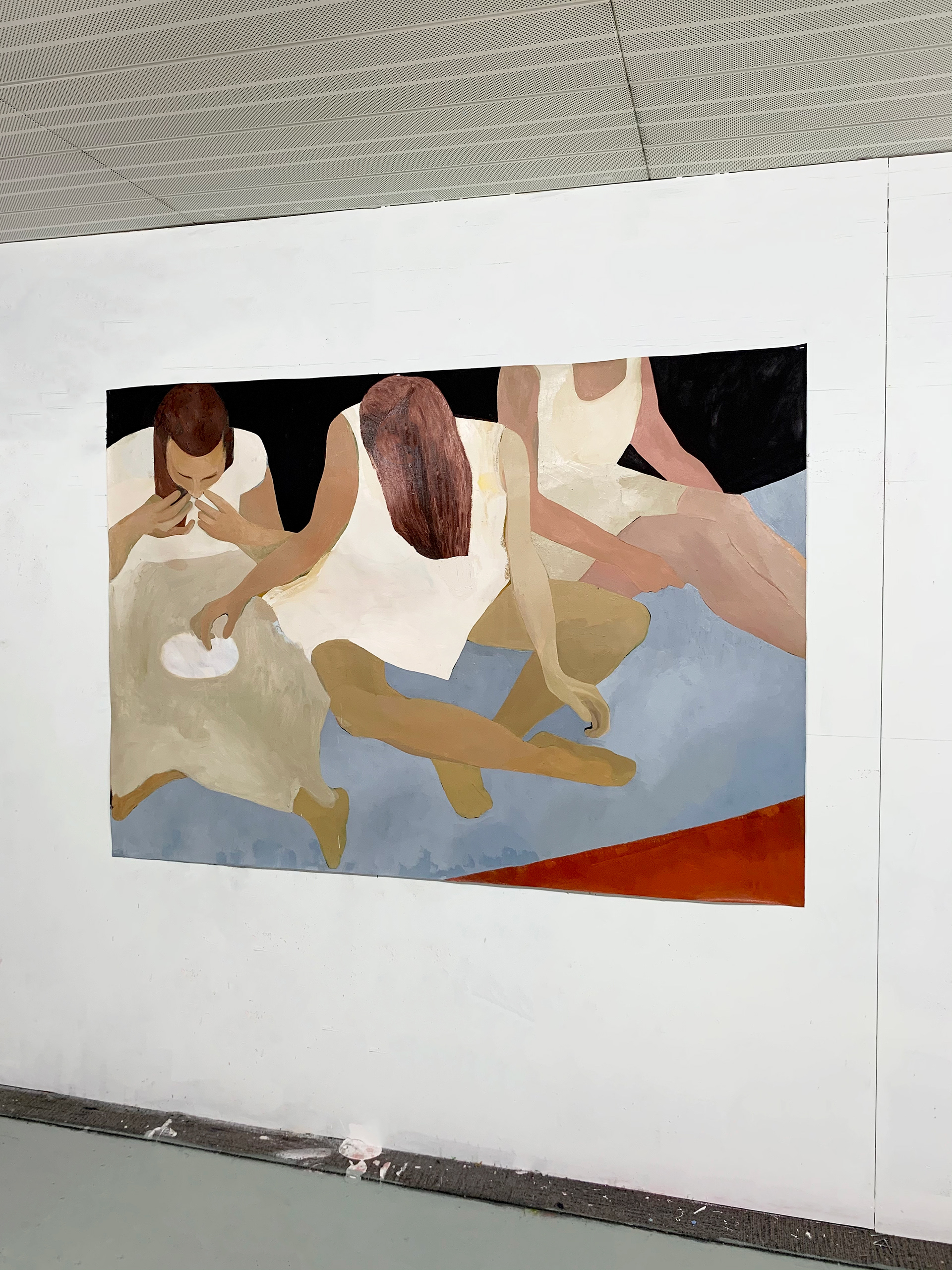Cette semaine, je suis très heureuse d’inviter et de vous partager mon entretien avec la talentueuse artiste londonienne Catherine Repko.
A travers ses peintures, l’artiste s’intéresse à la dimension de « Sisterhood ». Un terme qui lui permet d’intégrer tous les moments qui unissent les femmes entre elles ou qui les relient par les mêmes étapes de vies qu’elles traversent. Plus fortes ensemble, les toiles de l’artiste sont souvent animées par des scènes de solidarités, de soutiens, d’intimités ou encore de joies. Mais pas que. Ce sont aussi des portraits féminins individuels à la dimension universelle qui composent l’œuvre de l’artiste.
Si Catherine Repko nous fait souvent le récit de moments précis, certaines de ses toiles sont quant à elles décrites à travers des points de vues resserrés et orientés sur un détail bien précis d’une scène qui aurait retenu son attention. Elles prennent, à l’égard des compositions plus larges, la dimension de portraits.
Toutes ses créations sont liées par la même ambition de l’artiste de pouvoir figer dans la matière un lien ou l’essence d’un moment particulier plutôt que de s’attarder sur l’identité de ses personnages.
C’est donc l’œuvre d’une artiste au regard particulièrement sensible et au talent de coloriste avéré que nous allons rencontrer.
A travers ses peintures, l’artiste s’intéresse à la dimension de « Sisterhood ». Un terme qui lui permet d’intégrer tous les moments qui unissent les femmes entre elles ou qui les relient par les mêmes étapes de vies qu’elles traversent. Plus fortes ensemble, les toiles de l’artiste sont souvent animées par des scènes de solidarités, de soutiens, d’intimités ou encore de joies. Mais pas que. Ce sont aussi des portraits féminins individuels à la dimension universelle qui composent l’œuvre de l’artiste.
Si Catherine Repko nous fait souvent le récit de moments précis, certaines de ses toiles sont quant à elles décrites à travers des points de vues resserrés et orientés sur un détail bien précis d’une scène qui aurait retenu son attention. Elles prennent, à l’égard des compositions plus larges, la dimension de portraits.
Toutes ses créations sont liées par la même ambition de l’artiste de pouvoir figer dans la matière un lien ou l’essence d’un moment particulier plutôt que de s’attarder sur l’identité de ses personnages.
C’est donc l’œuvre d’une artiste au regard particulièrement sensible et au talent de coloriste avéré que nous allons rencontrer.

Catherine Repko / The image is is courtesy and copyright of Catherine Repko.
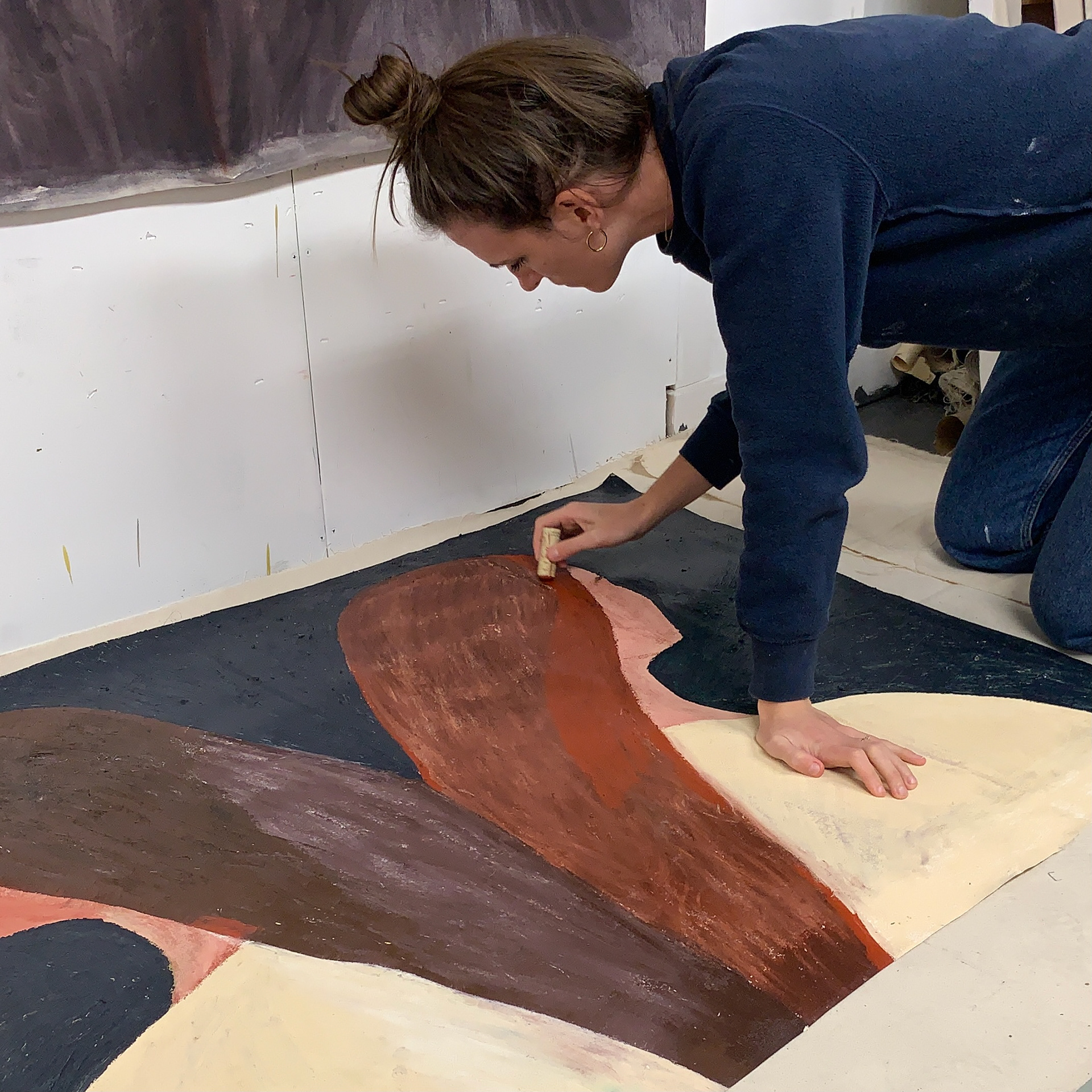
Studio Shot / The image is courtesy and copyright of Catherine Repko.
Could you introduce yourself?
My name is Catherine Repko, I'm a London based artist currently in my final year on the MA Painting programme at the Royal College of Art. I came to the UK when I was 19 to study my foundation in art at Chelsea College of Art and Design, and I went on to study my BA in Visual Communication at the University of Brighton, where I also did a semester abroad at the Minneapolis College of Art and Design in Minnesota, USA. I've been interested in artmaking since I can remember - probably just the same as most children, but I was really lucky with a few art teachers growing up who were really encouraging and gave me a confidence as a kid to think it was something I could keep doing, so I was really lucky in that. My family was also incredibly lucky in that my dad's job took us to live on the outskirts of Florence from when I was 5 to 9 years old, which was an incredibly formative period of my childhood. My parents were great at taking my sisters and I on family trips to other European cities, they brought us to galleries and they kept us exposed to and engaged with the arts and culture throughout our childhood and young adult lives. Our lives changed a lot when we got a bit older into our teens, but those early years were so formative for all four of us, and I can see now as a 30-year old how important that time was for me: how it shaped my identity as a human and how it seeps into my studio practice today.
You do most of all figurative paintings and work on paper of women. And I notice that sometimes your creations introduce a scene with a great tight framing on a detail of a character or a scene that we could imagine bigger. It confer an intimate character of the depiction. You offer us an overview as if you want to preserve a moment that you witnessed. Is it what you want to create ? Could you speak about that kind of scenes your create?
Yes, the series of works I've been making over the past 18 months has specifically been inspired by the relationships between my three sisters and I. This is a departure point, but I use the word 'sisters' broadly, encapsulating close female relationships of many kinds - close friends you consider your sisters, cousins who are lifelong best friends, the very close relationships experienced as young girls, and then as teens and how those relationships look now as grown women. And of course then within that there are themes that flow throughout the works like a sister getting married, or becoming pregnant, becoming a mother. In the work I'm interested most in the space between us, and in the ineffable experience. There are also some things that are really hard - it's not all just about joy and embracing and love, the work is simultaneously about grief, longing, isolation and pain. Though ultimately, it's about support.
Yes, the series of works I've been making over the past 18 months has specifically been inspired by the relationships between my three sisters and I. This is a departure point, but I use the word 'sisters' broadly, encapsulating close female relationships of many kinds - close friends you consider your sisters, cousins who are lifelong best friends, the very close relationships experienced as young girls, and then as teens and how those relationships look now as grown women. And of course then within that there are themes that flow throughout the works like a sister getting married, or becoming pregnant, becoming a mother. In the work I'm interested most in the space between us, and in the ineffable experience. There are also some things that are really hard - it's not all just about joy and embracing and love, the work is simultaneously about grief, longing, isolation and pain. Though ultimately, it's about support.
I often crop images really tightly to try to focus in on a specific moment, removing a lot of the noise and detail to leave what is necessary. I really want to capture a mood, a fleeting moment to make it lasting. I want the work to take an intimate look at sisterhood but also arise contemplations surrounding identity, of being daughters, about motherhood, our humanity – at a time that feels so increasingly polarised both socially and politically, I want to bring togetherness to the forefront.
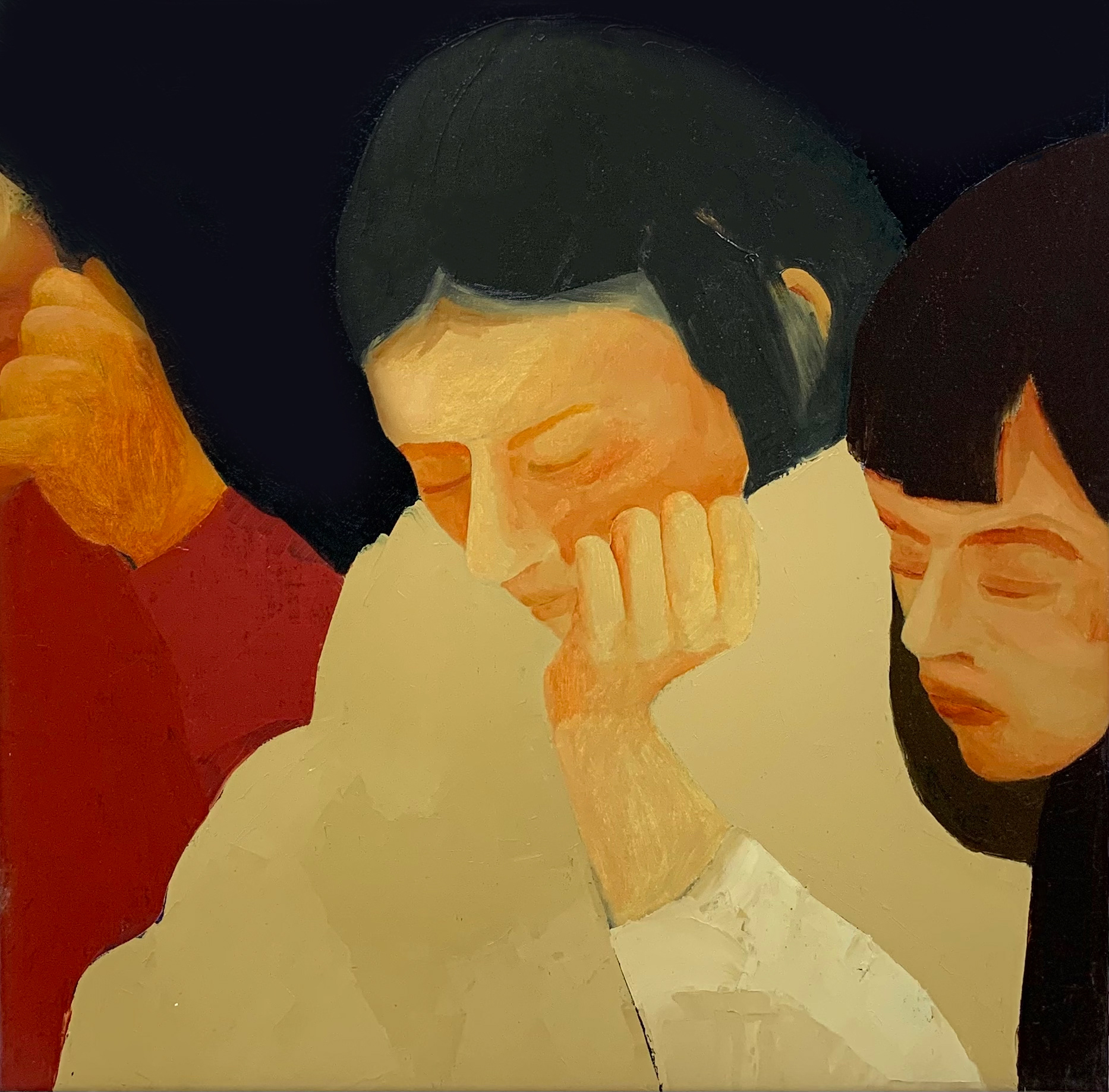
You were never alone, Oil on linen, 45 x 45 cm, 2020 / The image is courtesy and copyright of Catherine Repko.
Even if you depict figurative paintings or drawings, I notice that you don’t draw all the times the facial features precisely. What is for you the most important to portrait someone or a group of persons?
Yes I've thought so much about the faces. You're right, most of my works do not include the details of the face. I want the figures in the works to come across as universal as possible so the viewer can place anyone (or noone) into the figures. Often I'll incorporate a simple profile, or a pose that leaves the face covered by falling hair, a sheer veil, or I'll simply cut the heads out of the frame altogether in a tighter crop. It is the space between them that interests me more than the identity of the figures, and I think it's difficult to avoid creating an identity when painting facial features. I try not to think about it too much, but yes - the faces are usually hidden or missing from the composition of that reason. In my work I think it's the shape and interaction of the bodies and the spaces created between those bodies that is important.
You mostly depict women and their interaction between them, in intimate scenes. Are they your close friends? And those scenes are they extracted from your daily life ?
I take inspiration usually from photos of my sister (or my friends) and I. I usually crop into a certain photo really tightly and use that image as a starting point for a painting - an initial outline, or underpainting - and then I completely disregard the reference image and I just start painting more intuitively. Very often the painting is only subtly related to the reference image once it is finished, as so much changes in the process of painting, as new forms reveal themselves and it begins to take its own direction.
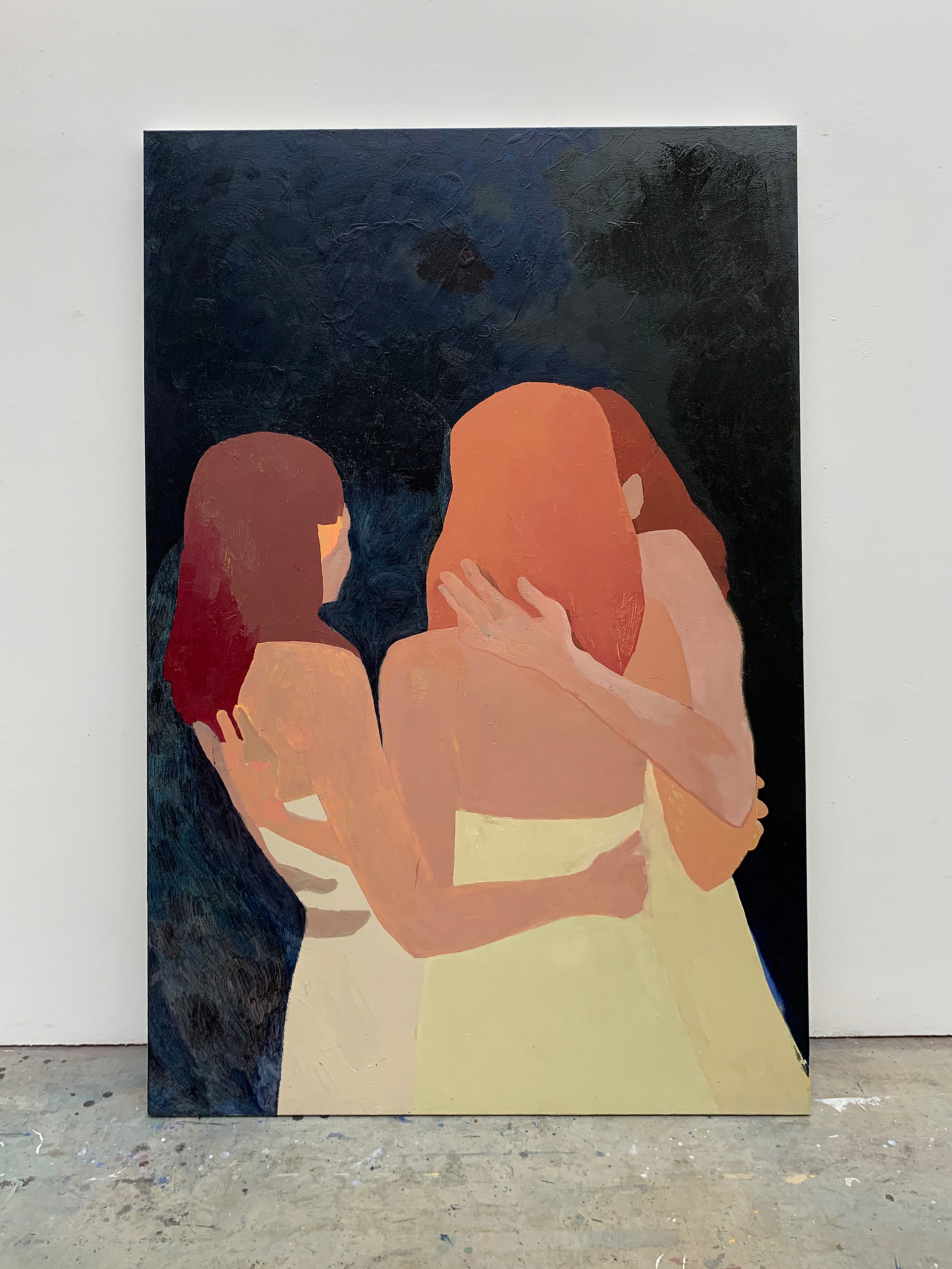
Sisters, Oil on canvas, 180 x 120 cm, 2020 / The image is courtesy and copyright of Catherine Repko.
You usually create in oil painting or in oil pastel and your creations are marked by your great sense of arrangement of flatness colors. It create some gloss surfaces, it catch our gaze. Could you speak about your artistic process and your choice of those materials ?
Yes I usually work with oil paints on canvas or linen. I sort of re-introduced myself to oil pastels during the first lockdown last April. When we had to evacuate the college I grabbed a bunch of newsprint paper from the print department and ordered some oil pastels and started working with them just on this super thin paper at home. I completely fell in love with the creamy texture and the intensity of the pigment in the colours! I basically became obsessed and it really opened up a whole new avenue in my practice. I've never really enjoyed 'drawing' in the traditional sense, but somehow with oil pastels it's like this halfway between drawing and painting that just felt right and worked really naturally for me. When we eventually got access to a studio space again in the late summer I got back to painting on canvas, but now with the introduction of pastels on paper alongside the paintings. I very recently started experimenting with adding marble dust to the oil paint and this is a material that I'm really excited about. It adds this texture to the paint that is so soft, velvety - and quite matte, which I really like. I do build up the paintings with sections of flat colour as you say, and the marble dust helps me flatten those areas even more, but in this really soft and inviting way - the paint behaves differently and becomes more sculptural, I can move it around on the canvas and flatten it out with my pallet knife, and the effect reminds me somehow of old frescoes. I'm really excited about that right now.
I notice that some of your paintings are in a same color palette that we could grouping by colors choices. Some of them or in soft color like purple, green, red and black. And some of them are in different shades of orange as the colors fire for the characters, highlighted by a deep black flatness background. Could you speak about those paintings? ( I think to the paintings called « Never made alone », « Sisters » or even « Hot summer » for the" fire colors" of the foot). And do you create by color series? Could we speak about series ?
I find it hard to analyse the colour choices as I feel like that is a really intuitive process of decision making while I'm painting, as opposed to something that's planned-out. For a very long time I made every colour from a very reduced pallet: Indian Yellow, Alizarin Crimson, Prussian Blue and Titanium White. It's incredible how many colours you can mix with such a simple pallet. Only in the last few months have I adopted a few more colours I've discovered that I love, but generally speaking the base pallet is still super simple, and mixing colours is to me one of the most enjoyable and intriguing parts of painting. So often one colour choice that works for a while in the painting will suddenly not work anymore when you've completed another part of the painting, and it sort of becomes this chase and balancing act between the colours and I really enjoy that. 'Sisters' (2020) is a good example of my colour pallet - the figures are painted in these muted tones of yellows/beiges/pinks and browns, but then they are set in this deep, dark background which sort of envelopes the three figures in a mysterious space, and I think really brings the focus onto the space between them and around them; I want that space to be a presence.
I find it hard to analyse the colour choices as I feel like that is a really intuitive process of decision making while I'm painting, as opposed to something that's planned-out. For a very long time I made every colour from a very reduced pallet: Indian Yellow, Alizarin Crimson, Prussian Blue and Titanium White. It's incredible how many colours you can mix with such a simple pallet. Only in the last few months have I adopted a few more colours I've discovered that I love, but generally speaking the base pallet is still super simple, and mixing colours is to me one of the most enjoyable and intriguing parts of painting. So often one colour choice that works for a while in the painting will suddenly not work anymore when you've completed another part of the painting, and it sort of becomes this chase and balancing act between the colours and I really enjoy that. 'Sisters' (2020) is a good example of my colour pallet - the figures are painted in these muted tones of yellows/beiges/pinks and browns, but then they are set in this deep, dark background which sort of envelopes the three figures in a mysterious space, and I think really brings the focus onto the space between them and around them; I want that space to be a presence.
I don't create by colour series. The aspect of series in my work I think applies to the subject matter or concepts much more than to the colours.

Veil of non-submission, Oil pastel on newsprint paper, 90 x 64 cm, 2020/ The image is courtesy and copyright of Catherine Repko.

Hot summer, Oil on board,33 x 37 cm 2021/ The image is courtesy and copyright of Catherine Repko.
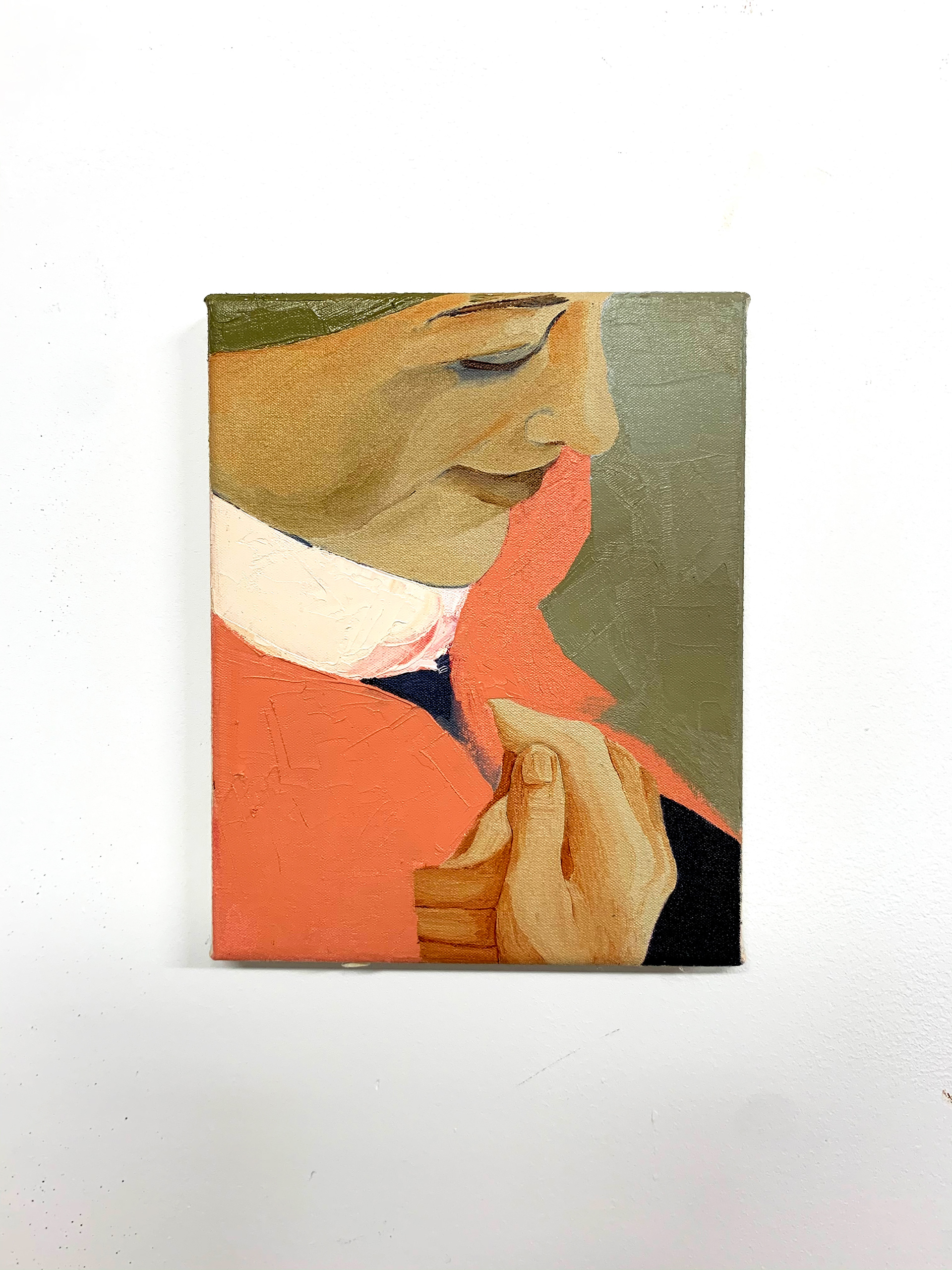
Rachel, Oil on canvas, 25 x 20 cm, 2020 / The image is courtesy and copyright of Catherine Repko
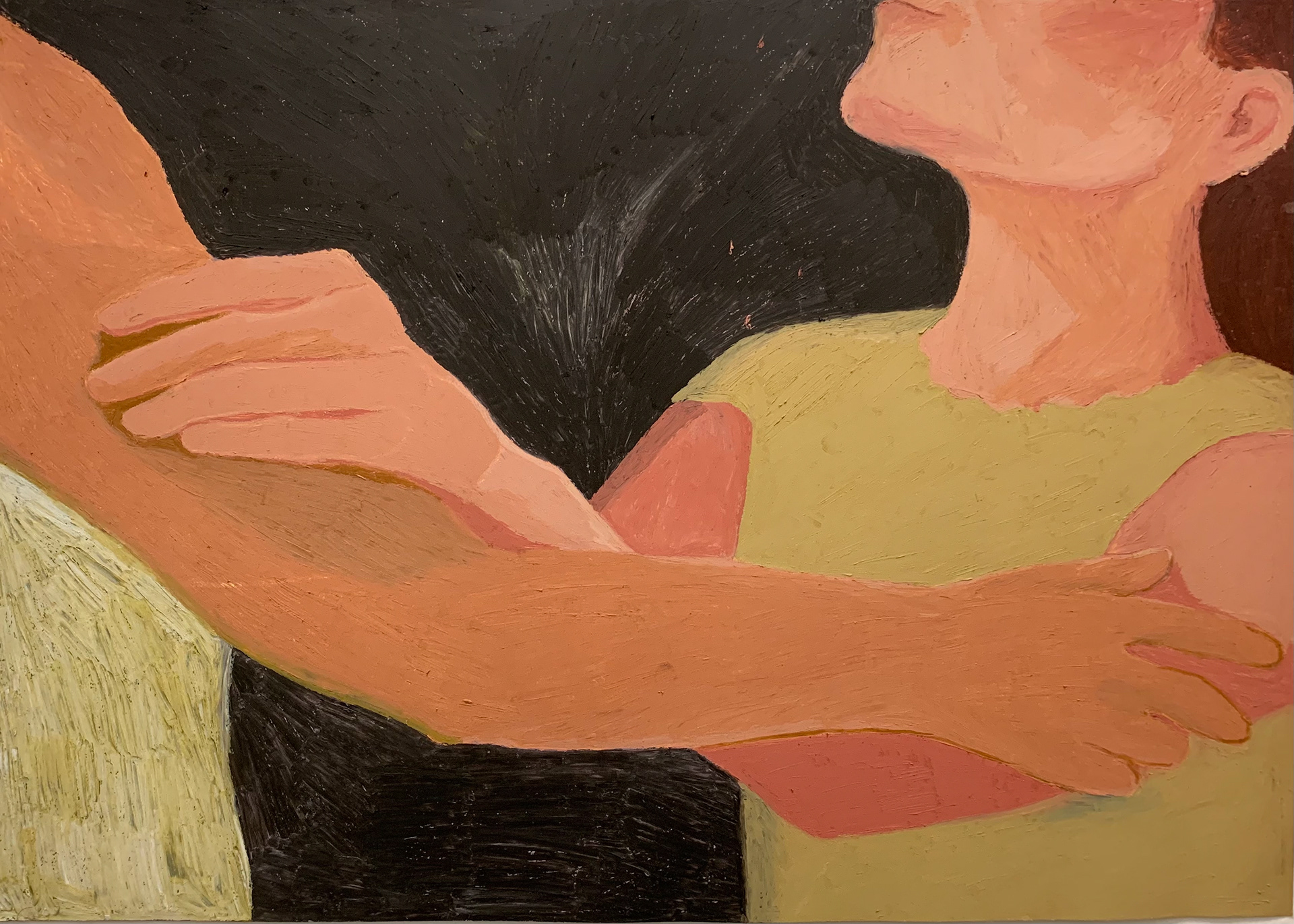
Moved by words (ii), Oil pastel on sugarpaper, 42 x 59.4 cm, 2020/ The images is courtesy and copyright of Catherine Repko
What are your main artistic inspiration?
My studio mates and classmates on the MA Painting programme are honestly the biggest inspiration, if I'm being completely sincere. Of course there are famous artists I follow and reference on some level, but it's the painters I'm working alongside, have crits with and speak to everyday that really inform the work and inspire me to get to the studio everyday, to keep pushing the work to be better, and to really value and appreciate the privilege of being an artist. I also know those years growing up in Italy as a child were incredibly influencial for me and I recognise this more now than ever before - I see references to Renaissance painting and fresco in some of the work in my studio, which was some of the very first art I was exposed to. I also have started to realise in the past year how much I think I have been influenced by my dad's visual documentation of our lives growing up - he kept what I now consider a visual diary of our lives as a family - he always had a video camera with us from the late 80s all the way through till the early 2000s when phones started taking over and things were changing for us as a family. We have boxes and boxes of film camera photographs of our family, at home and on our travels, I have a folder full of DVDs converted from the old VHSs he took in those years - but not just of me and my sisters, but also these crazy sort of tours of the places we lived or places we went to. It's kind of incredible, and I see it so much in the work I make now in my painting - I feel like what compelled him to record the way he did is the same thing that compels me to paint how I paint - it goes back to chasing the ineffable.
Do you have any current or future projects to share with us?
I'm currently in the final stretch of my MA in Painting at the Royal College of Art. Our two-year programme has been massively disrupted by Covid and staff strikes before that, so it feels a little bit surreal to be in the lead up to 'graduation' now. I'm extremely angry with the university, but they have told us at least that they will provide us with a physical graduate show this summer, but the details are yet to be confirmed by the RCA. I have a few shows coming up, mostly here in London:
12 -18 April - Held : Two person show with Lucy Whitehead at Blueshop Cottage, London
26 - 30 April - NOW: New Work Now : Online solo showcase with Huxley Parlour Gallery, London
19 - 23 May - The Drawing Room : Group show with Berntson Bhattacharjee Gallery, London
9 June - 3 July - Two person show with Anne Carney Raines at Wilder Gallery, London
November - Solo show with A. More Gallery, Milan
